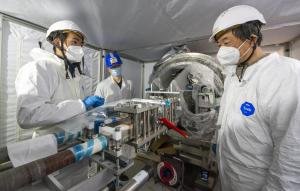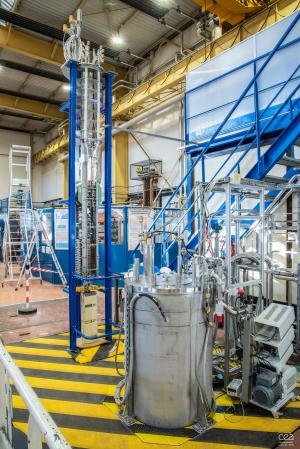Making ends meet
The one-million-component ITER machine is far more complex than a space probe, a deep-sea submarine or a Mars rover. In order to fulfil its operational objectives it relies on the optimal performance of innumerable interdependent systems and devices, most of which, fortunately, can be tested prior to integration and commissioning. In a few cases however, such testing is impossible and responsible officers are faced with a daunting challenge: how to make sure that an untested component will perform as expected once the machine is up and running?
The joints need to be assembled in situ, once all the magnet feeder's elements are in place. What is expected from the joints is to oppose as little resistance to the current flow as possible: in theory, they should be as superconducting as the rest of the network that delivers up to 70 kA of electrical current to the magnets. In reality, what is needed is to limit the heating that would result from electrical resistance.
However, once in place and assembled, a joint's electrical performance can only truly be put to the test at the ITER operating temperature (4 K, or minus 269 °C) and high-current (up to 70 kA), which will only be reached when the machine is commissioned. Detecting a problem at this stage, however, would lead to loss of time for repairs—a situation the team is determined to avoid by developing qualification programs for the technicians who will realize joint assembly and establishing precise procedure controls and step-by-step acceptance tests on samples and mockups produced throughout the qualification program to demonstrate technician skill.
Over the past decade, different ITER Domestic Agencies have engaged in the development of the feeder component that fell within their scope. As far as feeder joints are concerned, the Institute of Plasma Physics of the Chinese Academy of Sciences (ASIPP) has been on the front line of research and development. With the close support of the ITER Organization feeder team and feedback from the ITER-CEA MIFI laboratory, ASIPP produced and qualified the first feeder joint sample in 2016. Qualification tests were performed in the Swiss facility SULTAN—the only installation in the world capable of imitating, within a significant magnetic field, the current intensity and temperature of ITER operational conditions. In that punishing environment the performance of the joints was confirmed.
As machine assembly is progressing on the ITER site, the time has now come to prepare for the actual implementation of the joints. A multiyear training program has already qualified several specialists from the TAC1 assembly teams. New samples, similar to those realized during the qualification stage, were produced and again successfully tested in the SULTAN facility.
Located at CEA-Cadarache on the other side of the ITER fence, SELFIE can be described as a small, close-to-home SULTAN. The main difference between the two facilities is that SELFIE is operating without an external magnetic field whereas SULTAN is equipped with a magnet that delivers a very strong field (4 tesla). In SELFIE the magnetic field is self-generated by the electrical current in the sample—hence the installation's name.
The SELFIE installation is encased in a 6.2-metre-tall, 0.86-metre-in-diameter cryostat hosting a thermal shield and a tank filled with liquid helium at 4 K. The helium inner tank accommodates both the superconducting transformer that delivers the 70kA current and the 3.60-metre-tall "sample" to be tested.
The conditions to which the samples will be submitted in SELFIE are similar to those the actual joints will face in the ITER coil termination boxes. The only parameter missing is the background magnetic field, but its influence is not essential to checking the baseline resistance value.
As actual joint assembly operations progress, the qualified specialists will be required to produce test samples every six months in order to verify that their performance remains at top level—an ingenious and efficient way of "testing" what cannot be tested.



